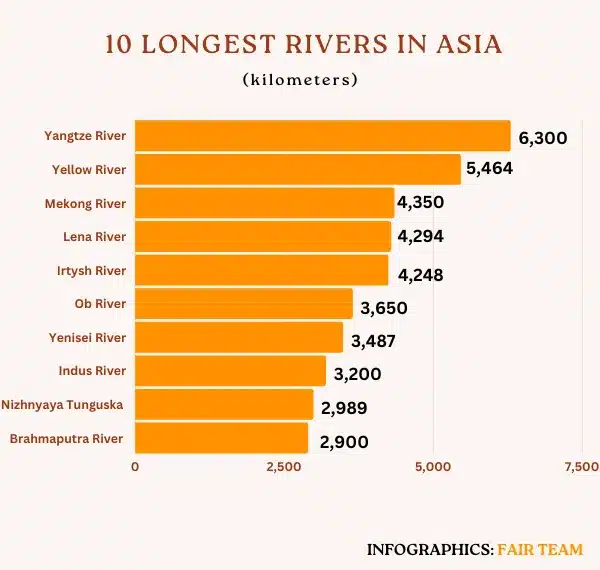Asia, the world’s largest continent, is blessed with a rich tapestry of landscapes and natural wonders. Among its many treasures, the continent boasts some of the longest and most iconic rivers on the planet. These sprawling waterways have played a pivotal role in shaping the history, culture, and economies of the regions they traverse. In this article, we embark on a journey to explore the ten longest rivers in Asia, each with its own unique characteristics and significance.
List of the 10 longest rivers in Asia
The 10 longest rivers in Asia are Yangtze River, Yellow River, Mekong River, Lena River, Irtysh River, Ob River, Yenisei River, Indus River, Nizhnyaya Tunguska River and Brahmaputra River.
Yangtze River (Chang Jiang), the longest river in Asia
Stretching approximately 6,300 kilometers (3,915 miles) across China, the Yangtze River is the longest river in Asia and the third-longest river in the world. It is often called the “cradle of Chinese civilization” as its basin has been inhabited for millennia. The river plays a crucial role in China’s agriculture, industry, and transportation, with major cities like Shanghai and Chongqing situated along its course.
Physical characteristics
Length: 6,300 km
Width: up to 800 meters
Depth: more than 30 meters
Yellow River (Huang He), the 2nd longest Asian river
Known as the “Mother River of China,” the Yellow River has a length of about 5,464 kilometers (3,395 miles). Like the Yangtze, it has been instrumental in the development of Chinese civilization. Historically, the river’s unpredictable flooding earned it the nickname “China’s Sorrow.” Today, extensive dam systems and flood control measures have been put in place to mitigate the impact of floods and ensure water availability for irrigation and consumption.
Physical characteristics
Length: 5,464 km
Width: Average 5-19 km ( at widest points)
Depth: Average 44m
Mekong River, the 3rd longest river in Asia
Originating in the Tibetan Plateau and flowing through China, Myanmar, Laos, Thailand, Cambodia, and Vietnam, the Mekong River is about 4,350 kilometers (2,703 miles) long. It serves as a lifeline for millions of people, providing water for agriculture, transportation, and fishing. The Mekong Delta, where the river meets the South China Sea, is one of the most fertile and biodiverse regions in the world.
Physical characteristics
Length: 4,350 km
Width: average 1.5 km
Depth: up to 90 meters
Lena River, the 4th longest Asian river
Flowing through the pristine wilderness of Siberia, the Lena River extends for about 4,294 kilometers. It is one of the three major Siberian rivers, along with the Yenisei and the Ob. The Lena River serves as a crucial waterway for transporting goods and plays a crucial role in the region’s economic activities.
Physical characteristics
Length: 4,294 km
Width: maximum 10,000 meters
Depth: maximum 28 meters
Irtysh River, the 5th longest Asian river
The Irtysh River, extending approximately 4,248 kilometers (2,640 miles), is a major river in western Siberia and Kazakhstan. It is a tributary of the Ob River and serves as a significant source of water for various industries and agriculture in the region.
Physical characteristics
Length: 4,248 km
Width: average 3,000 meters
Depth: Average 9 meters
Ob River, the 6th longest river in Asia
The Ob River is the westernmost of the three great Siberian rivers, flowing across Russia for about 3,650 kilometers (2,268 miles). It is an important trade and transportation route, especially during the warmer months when it is navigable.
Physical characteristics
Length: 3,650 km
Width: average 3,000 meters
Depth: Average 9 meters
Yenisei River, the 7th longest river in Asia
The Yenisei River, one of the longest and most significant rivers in the world, flows through the heart of Siberia in Russia. It is a crucial lifeline for the people and ecosystems of Siberia. The Yenisei River is also a vital source of hydroelectric power generation, with several dams built along its course. These hydroelectric plants contribute significantly to Russia’s energy production and supply.
Physical characteristics
Length: 3,487 km
Width: 90-5000 meters
Depth: Average 14 meters
Indus River, the 8th longest Asian river
The Indus River, one of the longest rivers in Asia, holds immense historical, cultural, and ecological significance in the Indian subcontinent. Originating in the Tibetan Plateau in China, the river flows through India and Pakistan, covering a distance of approximately 3,200 kilometers before emptying into the Arabian Sea.
The river’s basin, known as the Indus Valley, was the birthplace of one of the world’s oldest civilizations, the Indus Valley Civilization, dating back to around 2600 BCE. The region’s rich history has left behind remarkable archaeological sites that continue to captivate scholars and tourists alike.
Physical characteristics
Length: 3,200 km
Width: average 19 to 26 km
Depth: average 124 ft
Nizhnyaya Tunguska River, the 9th longest Asian river
The Nizhnyaya Tunguska River is a significant waterway located in the Krasnoyarsk Krai region of Siberia, Russia. It is a major right tributary of the Yenisei River, and its name “Nizhnyaya Tunguska” translates to “Lower Tunguska” in English, to distinguish it from the Upper Tunguska River, which is a separate watercourse.
The river originates in the Eastern Sayan Mountains and flows through a remote and sparsely populated region of Siberia. It spans a length of approximately 2,989 kilometers (1,857 miles) before eventually merging with the Yenisei River.
Physical characteristics
Length: 2,989 km
Width: average 300-400 meters
Depth: 60 to100 meters
Brahmaputra River, the 10th longest river in Asia
The Brahmaputra River is one of the most significant and majestic waterways in Asia, coursing through multiple countries and playing a vital role in the lives of millions. Originating from the Angsi Glacier in Tibet, it carves its way across the Tibetan plateau, traversing through India, and eventually forming the border between India and Bangladesh before emptying into the Bay of Bengal.
Stretching approximately 2,900 kilometers (1,800 miles), the Brahmaputra holds various names along its course. In Tibet, it is known as the Yarlung Tsangpo, and in India, it bears the name Brahmaputra. As it enters Bangladesh, it is referred to as the Jamuna River.
The river is renowned for its massive water flow, ranking among the world’s largest in terms of discharge.
Physical characteristics
Length: 2,900 km
Width: average 5.6 km
Depth: maximum 120 meters
Summary of the 10 longest rivers in Asia
The 10 longest rivers in the world are:
- Yangtze River; 6,300 km
- Yellow River; 5,464 km
- Mekong River; 4,350 km
- Lena River; 4,294
- Irtysh River, 4,248 km
- Ob River; 3,650 km
- Yenisei River; 3,487 km
- Indus River; 3,200 km
- Nizhnyaya Tunguska River; 2,989 km
- Brahmaputra River; 2,900 km
In conclusion, the rivers of Asia have witnessed the rise and fall of civilizations, shaping the course of history and serving as lifelines for the communities that depend on them. From the majestic Yangtze to the sacred Ganges, these waterways embody the significance of nature’s bounties in sustaining life and civilization. As custodians of these vital resources, it is crucial for humanity to cherish, protect, and responsibly manage these magnificent rivers for generations to come.








